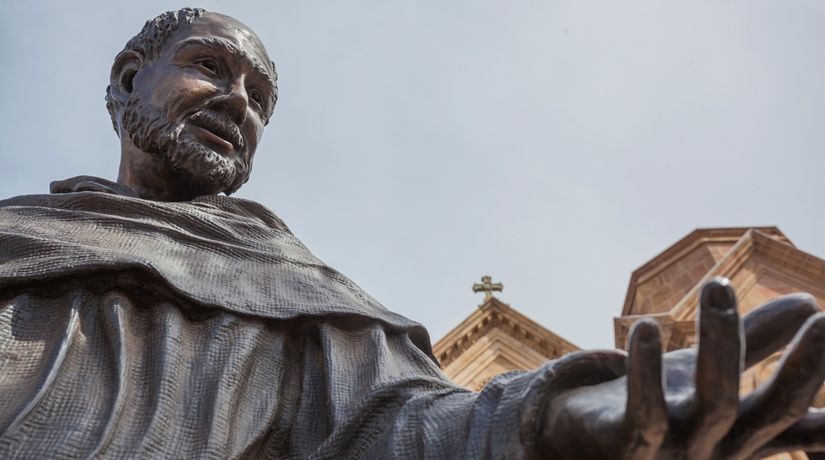Perhaps three quarters of Christians belong to churches that pray to dead saints. But is that what God wants? What does the Bible say about prayer and saints?

A few years ago an acquaintance was telling my wife and me about a tradition that would purportedly ensure you would be able to sell your house quickly. You were supposed to bury a statue of St. Joseph upside down in your yard.
I admit I wasn’t sure if she was making this up, but The Wall Street Journal verified the custom: “Popular belief holds that people who wish to enlist St. Joseph’s help in selling a house should bury his replica upside-down in the yard. (Apartment dwellers are advised to put him in a potted plant.)”
The newspaper article even told about New Yorkers Cari Luna and her husband, who were having a hard time selling their house, as offer after offer kept falling through.
“‘I wasn’t sure if it would be disrespectful for me, a Jewish Buddhist, to co-opt this saint for my real-estate purposes,’ says Ms. Luna, a writer. She figured, ‘Well, could it hurt?’”
Praying to saints
Joseph is just one of hundreds of saints that Catholics, Eastern Orthodox and members of some other churches turn to when in need.
Catholic.org explains, “For example, many people ask Saint Monica to pray for them if they have trouble with unanswered prayers, because Monica prayed for twenty years for her son to be converted. [Her son became St. Augustine]. …
“Francis of Assisi loved nature and so he is patron of ecologists. Francis de Sales was a writer and so he is patron of journalists and writers.”
St. Sebastian is considered the patron saint of athletes and, coincidentally, of the 2016 Olympic host city of Rio de Janeiro. (The full name of the city is São Sebastião do Rio de Janeiro, Portuguese for “St. Sebastian of the January River.”) Religion News Service reported as the Olympics were about to begin:
“Today, some athletes wear St. Sebastian medals, carry St. Sebastian rosaries or prayer cards and recite one or more of several prayers dedicated to the saint. Here’s one:
“‘St. Sebastian, patron saint of athletes and sports, help me to do the best that I can, aim high and always give it my best effort, and if I should fail, give me the strength to try harder. Amen.’”
Another saint that was very popular for centuries was St. Christopher. But in 1969, “the Church took a long look at all the saints on its calendar to see if there was historical evidence that that saint existed and lived a life of holiness. In taking that long look, the Church discovered that there was little proof that many ‘saints,’ including some very popular ones, ever lived. Christopher was one of the names that was determined to have a basis mostly in legend. Therefore Christopher (and others) were dropped from the universal calendar” (Catholic Online).
Naming saints
Now the criteria for being named a Catholic saint are much stricter. To be called a saint, generally a dead person must be credited with having performed two miracles.
According to Catholic Online, “Since miracles are considered proof that the person is in heaven and can intercede for us, the miracle must take place after the candidate’s death and as a result of a specific petition to the candidate.”
But is that what the Bible says?
What are saints?
According to the Bible, all true Christians are called saints (see Acts 9:13, 32; Romans 1:7; 8:27; Ephesians 1:1). Sainthood was not something reserved for dead miracle workers. (See our Discern magazine article “You Can Become a Saint!” for the biblical definition of the term and what it means for you.)
What about the thousands of saints who have been recognized by the Catholic and Orthodox churches? Does the tradition of making statues of saints and praying to saints go back to the Bible—or to some other source?
A full history of the veneration of saints is beyond the scope of this article. But consider a couple of fascinating threads.
Rodney Stark, codirector of the Institute for Studies of Religion at Baylor University, traced the assimilation of paganism into the Roman Church in his book The Triumph of Christianity. “The peasants tended to respond to Christianity as they always had to the appearance of various new gods within paganism—to add the new to the old, rather than to replace it. Hence Jesus and various saints were simply added to the local pantheon” (2011, p. 196).
This process included making pagan temples, magical springs and pagan festivals “Christian” by associating them with martyrs and their relics (bones, hair, etc.). Dr. Stark points out, “It also has been generally accepted that some minor local saints are overlays of equally minor, local pagan deities” (p. 197).
But does this just apply to minor saints?
Some art historians have noted fascinating parallels between pagan Roman art and early Christian art. Often pagan art would feature a powerful god like Jupiter surrounded by less-powerful gods. When the Roman Church began accepting religious art (more than a hundred years after the time the Bible was completed), the artists followed a similar pattern. They turned major gods like Jupiter and Apollo into God and Christ and replaced the lesser gods with saints. (For more background on this, see our Discern article “Where Did the Popular Image of Jesus Come From?”)
As with many aspects of the pagan world, Roman gods seemed to be transformed and replaced by saints. For example, Cupid, the god of love, was reborn as St. Valentine, the saint of love. (Read more about the syncretism of pagan customs into Christianity in our articles “Was Christianity Designed to Evolve?” “Holy Days vs. Holidays,” “Valentine’s Day Is Pagan? So What?” and related articles.)
Where are the dead saints?
The practice of praying to saints is based on the idea that they are now in heaven listening to those prayers. But what does the Bible say about where the saints are today?
Jesus Christ plainly said, “No one has ascended to heaven” (John 3:13). The apostle Paul stressed the need for Christians to be resurrected—brought back from the dead. And he explained when this resurrection will happen—“at the last trumpet” (1 Corinthians 15:51-52) at the return of Jesus Christ to this earth. “For the Lord Himself will descend from heaven with a shout, with the voice of an archangel, and with the trumpet of God. And the dead in Christ will rise first” (1 Thessalonians 4:16).
What a wonderful privilege to be able to go directly to God! We don’t need human or angelic intermediaries.
As strange as it sounds to the billions who have always been taught that the dead go immediately to heaven at death, the Bible says no. Christians—the real saints—are still in their graves awaiting Jesus’ return and their resurrection! Read more about this in the article “Do We Go to Heaven When We Die?”
Jesus’ instruction on prayer
Jesus taught His followers to address their prayers directly to God the Father, and He said we should do it in His name (Matthew 6:9; John 14:13). What a wonderful privilege to be able to go directly to God! We don’t need human or angelic intermediaries, since Jesus Himself is the “one Mediator between God and men” (1 Timothy 2:5).
We can and should each regularly “come boldly to the throne of grace, that we may obtain mercy and find grace to help in time of need” (Hebrews 4:16).
Who do the saints pray to (and worship)?
The followers of Christ—the saints—obeyed His instructions and prayed to the Father. They worshipped God only.
The Bible records a time when the apostle John came into the presence of a powerful spiritual being, and even though he was in awe and fell down before the being, he was quickly reminded to only venerate and worship God.
“Then he said to me, ‘See that you do not do that. For I am your fellow servant, and of your brethren the prophets, and of those who keep the words of this book. Worship God’” (Revelation 22:9).
Could veneration of saints be idolatry?
The information above raises important questions:
- If saints are dead in the grave, not in heaven, why would we pray to them?
- If we can talk directly to God, with Jesus Christ interceding for us, why would we pray to saints?
- Can we be sure the miracles attributed to dead saints are truly miracles—or if they are miracles, what their source is? The Bible shows that not all miracles are of God, and those who did not obey all of His commandments would not be true saints or perform miracles from God. (Learn more in our articles “False Prophets” and “Simon the Sorcerer.”)
- If veneration of saints resembles veneration of the pantheon of pagan gods, wouldn’t it be idolatry to pray to them? (Learn more about what God says about idolatry in our article “Second Commandment: You Shall Not Make a Carved Image.”)
The biblical answer is that we should worship and pray to God only—not to saints. Read more about how God does want us to pray in our free study guide How to Pray.





